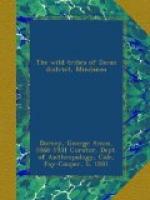Lieutenant Youngblood gives the following description of the people and dwellings seen by him near the upper waters of the Agusan river:
“The people seemed to be living in an atmosphere of fear as far as intercourse with the world outside their crater-like valley was concerned. They believed it was death to look upon the sea, of which they had heard disjointed tales, but which none of them had ever seen. They feared the coast people with a mortal fear, justified perhaps by the experiences of occasional meetings in times gone by. They fear each other to a certain extent, especially men who live further north of the headwaters of the Agusan. This ever-present state of fear gives coloring to their whole life. They take to the brush at the least unwonted sound. They make their clearings on the steep mountainsides and in these build two or three of their houses in strategic positions. In the very construction of their dwellings the idea of security in case of attack is predominant.
“The houses in this section are generally built in clearings on the sawn-off trunk of some giant tree and placed from the ground some forty or fifty feet. Numerous posts help support the structure, entrance to which is gained by a notched pole firmly set in the ground and held in place by tightly wound bejuca. Oftentimes this stair pole is bowed outwards slightly, which gives it a peculiar appearance and requires a considerable amount of skill in climbing. The front and only door to these houses consists of a section of the floor composed of hewn plank, hinged at one end. One end of this is raised by a bejuca rope during the day, while at night it is let down forming a solid floor throughout the house.
“The roof is of shingles made from mountain cane; the floor and sides of hand-hewn logs and planks; the roof is at no place more than seven feet from the floor and is blackened on the inside from smoke. The largest house visited in this locality was that of Chief Leuanan, and this was some twenty feet square. These houses consist of one room and are inhabited by two or more families.”
AGRICULTURE
About the settlements are the fields in which rice, corn, camotes, sugar-cane, and a small amount of tobacco, cotton and hemp are raised. However, the crops are usually so small that even with the addition of game and forest products there is, each year, a period closely bordering on starvation. New clearings are frequently made near to the old, for the primitive tools[1] with which the people work are ill-fitted to combat the incursion into the open land of the rank cogon grass. Only the exhaustion of suitable timber land for a new clearing, the prevalence of an epidemic, or the near approach of a powerful enemy will cause the people to move their homes from one district to another.
[1] These consist of a mall axe, working knife, and planting stick.




